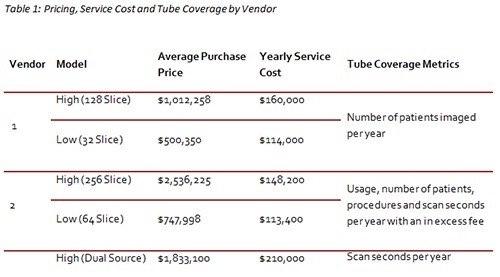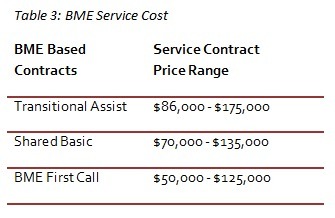CT service contracts: Avoid uncertainty when choosing the appropriate coverage
August 19, 2015
Determining the best service option can feel a little like playing Russian roulette – should you choose the equipment manufacturer (OEM), a third-party service organization, equipment maintenance insurance, asset management, in-house biomedical engineering or a combination of these?
This uncertainty has only been magnified as the Centers for Medicare & Medicaid Services (CMS) began enforcing strict compliance with equipment manufacturers’ maintenance protocols and schedules in 2010. Although this increases hospital accountability and patient safety, it also requires significant upfront costs.
The Joint Commission estimates this change will cost the health care industry between $2 billion and $5 billion. With hospital equipment maintenance increasing 2-3 percent each year and accounting for over $40 billion annually, this equates to between $4,000 and $7,000 per bed, or millions in general expenses for hospitals.
In addition to CMS compliance, there is potential for lost revenue if equipment experiences downtime, and also liability consequences when equipment malfunctions occur due to improper preventive maintenance. Navigating coverage decisions can be overwhelming and confusing, especially for high-impact service areas, such as CT, in which service contracts depend heavily on a combination of several different factors.
One important thing to keep in mind is that in some cases approximately 40 60 percent of a vendor’s revenue comes from service contracts, which means the vendor is always looking to negotiate the highest level of service at the highest price, regardless of a facility’s needs. With that in mind, here are a few key things to consider when choosing service coverage for CT.
Factors That Influence CT Coverage
• Tube coverage.
• Hours of coverage required for principle cover period and preventive maintenance (PM).
• Base system configuration.
• Peripheral devices.
• Computer Refresh Upgrades
• Remote Diagnostics
• Exam Coverage
• Uptime Guarantee
• Technical and Applications Support
• Phone and On-Site Response times
• ACR Support
• Radiation Dose Watch with Reporting Tools and Analytics
• System Performance Reports
• System Utilization Reports
• Parts Delivery
• Additional Educational Expenses with CEU credits
• Discount on parts in the service contract
Although each of these factors can influence coverage and service cost, understanding how vendors measure tube coverage is often one of the most confusing components. Each vendor evaluates this based on different metrics. Table 1 shows this for the four most popular vendors in the market.
Most Service Contracts Are Customizable
Vendors may not offer this option at first, but you should always ask. This option allows a facility to choose the service type and coverage, uptime guarantee, hours, etc., according to its specific caseload or patient volume. These contracts can include transitional Coverage from full service and in-house support throughout the contract term if needed. Choosing a service contract also depends on the amount of risk you are willing to take.
Slice Count
As a general rule, CT scanners with a higher slice count require more service coverage. This is reflected in Table 2, in which service contract price ranges are broken down by slice count.
What Parts Need Coverage?
Tube coverage is almost always recommended if the system has high volume and stroke and/or cardiac programs. Even if the tube is covered with a specific number of slice counts, rotations, scan-seconds and/or the number of patients, there may be a per use or in-excess, “debit” fee-associated charge.
Other optional items to consider including in the contract coverage are peripherals (advanced 3D visualization solutions, portal server(s), UPS, injectors, etc.), which are often third-party devices. Coverage for these items is best handled under the OEM contract.
Coverage Hours
Typically, the full-service contracts that are recommended for CT scanners include extended hours for considerably high volume (Monday to Friday, 8 a.m. to 9 p.m.) or routine hours for lower volumes (Monday to Friday, 8 a.m. to 5 p.m.). The hours of 5 p.m. to 9 p.m. are generally for scheduled PMs.
For a CT scanner being utilized 24/7, extended hours to midnight or 2 a.m. can be cost effective. In some cases, Saturday coverage could be recommended with standard business hours from 8 a.m. to 6 p.m.
Point-of-sale Service Contracts Are Usually Less Expensive
Negotiating the service support contract with the purchase can lower your operating costs by 1-3 percent per year during a contract negotiated at warranty expiration.
BME-based Contracts
For hospitals that want in-house coverage, the three main options to consider are transitional assist, BME first-call contracts and shared-risk contracts. These types of contracts are highly practical for large facilities that have multiple scanners and appropriately trained BME resources.
Transitional assist contracts offer a fullservice contract for the initial year while BME personnel are being trained, but are often much more expensive than fullservice contracts. BME first-call contracts offer troubleshooting and PM only, and a discount on parts, labor and X-ray tubes. These are usually lower in overall service costs than full-service contracts.
Sharedrisk contracts are designed for those facilities that are willing to share in the risk of service but also want an opportunity to reduce their costs. Through the use of a deductible, the service provider can cap your service repair costs. The customer pays on a call-by-call basis for each repair. If the CT scanner has only a few repairs throughout the year, you can minimize your costs by not meeting your deductible. If your equipment has numerous repairs, your total expenses are capped. The chart above lists service contract price ranges for BME contracts.
Contract Language
It is important that all contracts include language that protects your facility. Throughout the years, MD B1uyline has gathered the “best of the best” in contract language and has created some protective clause templates that we recommend you include in your purchase orders and contracts. Below are some of the most recommended clauses.
Multiyear Service Contracts This will provide additional value because these contracts are typically priced lower. With these, you will want to negotiate paying on a yearly basis and at a fixed rate throughout the contract term. In addition, you will want the option to change contract levels depending on the performance of your system or renegotiate price depending on the quality of your service.
Performance Guarantee Clause
This will protect your facility and ensure that the equipment is performing to the agreed-upon performance specifications and will eliminate any finger-pointing if a service issue arises.
Response Time Guarantee
Response time to service problems is vital in choosing a service contract, especially with systems that can’t afford downtime. These must be provided in writing and acceptable to the hospital before the purchase order is issued.
Uptime Guarantee
Many vendors will provide a 95-98 percent uptime guarantee on their equipment. Vendors typically calculate uptime guarantee on a 24/7basis, but it is likely that your facility does not operate its CT scanner 24/7/365. Uptime guarantee should be calculated during your specific hours of operation, not based on times that your system is not going to be in operation.
Termination Clause
All contracts should have a termination clause that allows your facility to terminate the entire agreement or terminate coverage of specific items within that contract. This will ensure that you avoid continuing coverage of equipment that is no longer being used, that no long needs service coverage, or that you no longer have.
Clauses that impose a penalty for termination should be deleted. Another consideration to take into account is whether the vendor offers programs like real-time remote diagnosis, Radiation Dose Watch, ACR, and Continuing Educational Units as part of its service contract.
In Summary
To put all this information in perspective, outside of capital and supply costs, service contracts are the next line item that can have a significant effect on the overall life cycle costs. They are a small but vital part of any purchasing discussion, and for some technologies, service contracts can be the difference between breaking even during the lifetime of the purchase or not.
Ms. Katie Regan joined MD Buyline in 2013 and brought with her seven years of clinical research experience. At MD Buyline, she leads all clinical, financial and general health care publishing projects. Ms. Regan received her Bachelor of Science from Texas A&M University and her master’s degree from Rice University.
Loretta Loncoske, BS, R.T. (R), Clinical Analyst Ms. Loretta Loncoske joined MD Buyline in 1991 with over 30 years of clinical experience in the high-end radiology modalities of MRI, CT, nuclear medicine, PET, interventional radiology and general radiology, and women’s health. She has held positions as director and assistant director of radiology at several facilities. Ms. Loncoske is a registered technologist and is certified by the American Registry of Radiologic Technologists in Radiology. She is a member of the American Society of Radiologic Technology and Healthcare Information and Management Systems Society.




